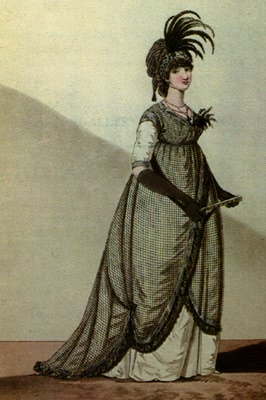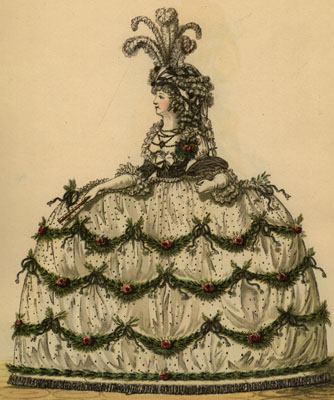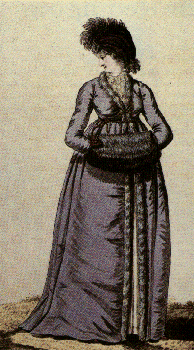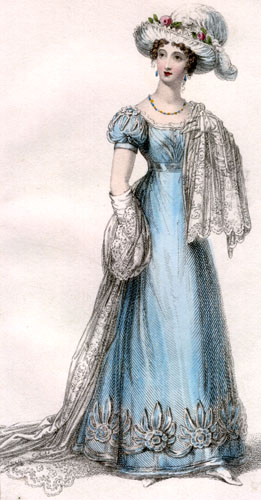What Should You Wear To The Ball?
Tonight is a big night and you absolutely must be wearing the perfect dress! With so many choices, what are you going to do?
One of the dresses is just right for you; but, which one is it?
(Click on the dress of your choice)
The opinion that dress expressed status in society was an unchallenged commonplace of the eighteenth century. The rulers of the country and the leaders of English society were a small group of noble families who controlled politics at home and in embassies abroad. They were an exclusive group, but from time to time their ranks opened to admit wealth acquired in the professions, commerce and banking and then closed again. Socially this group formed the society of the court, and the core of fashionable society.
It was this exclusive group that served as the exemplary figures of fashion for all classes of English life. As new fashion made its way to England from France, the fashion capital at that time, the upper class was quick to adapt to the new fashion. However, it was not only the upper class that was fashionable; the lower and middle classes also adapted the same fashion trends only the fabrics were less expensive and the outfits less luxurious(Buck 12).
In terms of following and defining the fashion of eighteenth century England, it is best to discuss the fashion of the upper class. For the greater part of the eighteenth century, it was to be width, not height, that was important. The mantua, developed in the late seventeenth and early eighteenth century, is a T-shaped gown with sleeves set in well below the shoulders, and the train trails. This was the most popular type of dress in the early eighteenth century. By the 1720s there had already been serious modifications in the cut. The gown lost its T-shape and the sleeves are set in at shoulder level. The train does not trail; instead it is stitched so that it lies face outwards (Rothstein 32).
The sack-ball gown was replacing the mantua at full dress balls and assemblies during the 1730s. Like the mantua, the sack had begun as a loose informal robe; unlike the mantua, it kept its flowing back, but it developed a bodice-front shaped to the figure. Until the 1770s, this was open over a stomacher; the fronts met with a center fastening. A version with a closed skirt disappeared in the 1750s and the sack, open down the center front, was worn with a matching petticoat. Until the 1770s when it began to disappear, the sack was worn on a wide range of occasions. For balls it was made more formal by the loose back being lengthened into a train becoming the 'dressed' or 'full-trimmed' sack(Rothstein 34).
The hoop, its size and shape, varied with the formality and informality of dress as well as changing in shape with time. It was at its widest in the 1740s and 1750s, oblong and fan shaped, but the large forms were limited to full dress wear(Cunnington 78). The ladies who intend to dance the minuet wear large hoped dresses, but others do not. The size of the hoop, apart from the court hoop, diminished from the 1760s but did not go completely out of wear until the 1780s. As the hoop grew smaller, the character of the dress changed. In the more informal gown, with fitted back, the fullness of the skirt moved towards the back and the line of the dress was broken and softened by the skirt being lifted up in loose puffs of material making a new style called a polonaise. This was worn at balls instead of the sack.
In the 1780s, new lines were showing themselves under a camouflage of trimming and the fabrics of the dress changing. Gowns were now often plain satins covered with festoons and flounces of gauze, flowers, and gold and silver foil; but, by 1790, muslin was the fashionable fabric. By this time, the gown has become of less importance; the white petticoat and vest with the waist marked by a sash will soon emerge as the new form (Peacock 26).
Men wore a suit of coat, waistcoat and breeches, all three garments matching in material and ornament; or two of them, coat and waistcoat, or coat and breeches, with a contrasting third. A contrasting waistcoat often appeared in court and dress wear and was likely to be the most richly patterned and ornamented garment of the three. In the first half of the century the fabrics used were the same as those of women's dress, gold and silver brocades for the grander occasions, damasks and corded and flowered silks for dress wear. Velvet, plain or figured in cut and uncut patterns, with or without embroidery, is more often found in men's suits than in women's gowns. Embroidered suits often had a coat and breeches in a colored silk and a waistcoat of white or cream repeating the embroidery of the coat but in contrasting colors (Rothstein 38).
The wig had been an important part of man's appearance since the middle of the seventeenth century; it remained so throughout the century with change only in the final years. It was a sensitive point of fashion, but wig also had a difference according to occasion. The full-dress wig of the beginning of the century was a particularly costly item of dress, with its mass of curls, rising high on the forehead each side of a center parting and falling over and well below the shoulders. The campaign wig was short, with the curls knotted at the back and over each shoulder, and was an undress or traveling wig. The bob, the plainest of all and always an undress wig, stopped short of the shoulders and was curled up all around. Lastly, the tie wig had the curls drawn back in a single tail with a bow of ribbon; the tail was sometimes enclosed in a bag (Rothstein 44).
The styles of the eighteenth century were always changing and being reformatted to better suit daily life as well as reusing and recycling fashions from the past. To be fashionable was very important in eighteenth-century upper class life, and this was reflected in the great fashions of the period.
or



